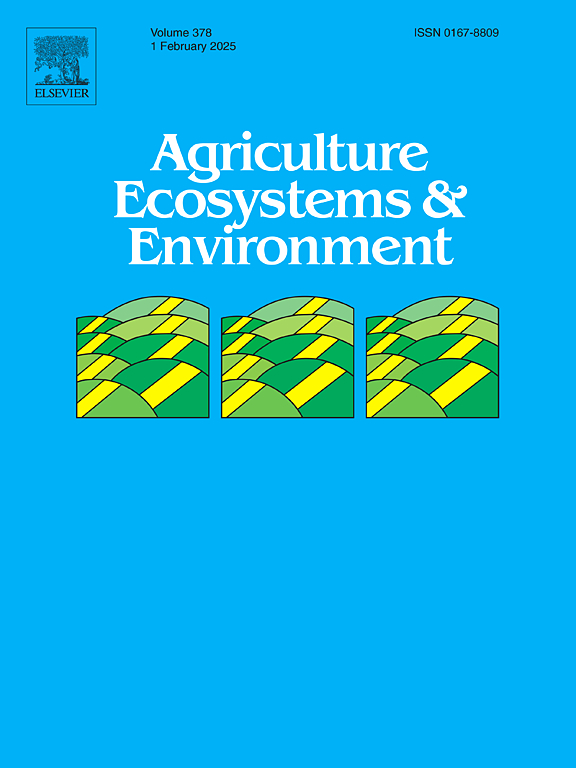中国黄土高原土壤二氧化碳动态随土壤深度对降雨模式的不同响应
IF 6.4
1区 农林科学
Q1 AGRICULTURE, MULTIDISCIPLINARY
引用次数: 0
摘要
土壤表层的二氧化碳(CO2)流出量不仅来自表层土壤,还与深层土壤的贡献有很大关系。在干旱和半干旱地区,土壤表层二氧化碳流出量随降雨模式的变化而显著波动。然而,不同土壤深度的土壤二氧化碳动态如何对不同的降雨模式做出反应,在很大程度上仍不清楚。为了填补这一空白,我们对位于半干旱黄土高原的耕地和果园中 10 厘米、50 厘米和 100 厘米深度的土壤二氧化碳浓度、温度和含水量进行了全年连续监测。对降雨事件进行了细致的记录,将其分为小雨(10 毫米)、中雨(10 毫米-40 毫米)和大雨(40 毫米),以确定其对土壤二氧化碳动态的影响。具体来说,小雨时土壤二氧化碳通量不受影响。中雨和大雨使 0-10 厘米处的土壤二氧化碳通量平均分别减少了 70% 和 83%。这种下降与不同降雨模式下气体扩散率的降低有关。例如,暴雨使 10 厘米和 50 厘米土壤深度的气体扩散率分别平均降低了 83% 和 53%。此外,在小雨期间,土壤二氧化碳浓度随着 10 厘米深度土壤温度的降低而略有下降。在中雨和大雨期间,10 厘米和 50 厘米深度的土壤二氧化碳浓度最初下降了 15%,随后又增加了 52%。这种反应很可能是受温度降低和随后含水量上升的影响,土壤二氧化碳浓度对温度产生了滞后反应。土壤二氧化碳浓度的快速增加主要是由于气体扩散率的大幅下降。值得注意的是,暴雨导致 50 厘米深的土壤含水量延迟上升,100 厘米深的土壤二氧化碳浓度显著下降了 16%。深土层土壤二氧化碳浓度的大幅下降主要与土壤温度降低有关。此外,观测到的土壤二氧化碳动态部分归因于耕地上的生物因素(微生物生物量碳和根系密度),但主要归因于果园下的非生物因素(土壤有机碳和容重)。总之,这些结果表明,表层土壤水分含量增加导致气体扩散率降低,而深层土壤温度降低导致生物过程减弱,这些因素通常会推动土壤二氧化碳动态对降雨模式的不同反应。本文章由计算机程序翻译,如有差异,请以英文原文为准。
Differential responses of soil CO2 dynamics along soil depth to rainfall patterns in the Chinese Loess Plateau
Soil surface carbon dioxide (CO2) efflux not only originates from topsoils, but also significantly involves contributions from deeper soil layers. Soil surface CO2 efflux significantly fluctuated with rainfall patterns in arid and semiarid regions. However, how soil CO2 dynamics respond at different soil depths to varying rainfall patterns remains largely unclear. To address this gap, we continuously monitored soil CO2 concentrations, temperature, and moisture content at 10 cm, 50 cm, and 100 cm depths in situ under cropland and orchards located in the semiarid Loess Plateau over a full year. Rainfall events were meticulously recorded, categorizing them into light (<10 mm), moderate (10 mm–40 mm), and heavy (>40 mm) to discern their impact on soil CO2 dynamics. Specifically, soil CO2 flux was not affected during light rainfall. Moderate and heavy rainfall decreased soil CO2 flux at 0–10 cm by an average of 70% and 83%, respectively. This decrease was associated with reduced gas diffusivity across rainfall patterns. For instance, heavy rainfall reduced gas diffusivity by an average of 83% and 53% at 10 cm and 50 cm soil depths, respectively. Furthermore, soil CO2 concentrations slightly dropped as soil temperature decreased at 10 cm depth during light rainfall. Soil CO2 concentrations at 10 cm and 50 cm depths initially decreased by up to 15% and subsequently increasing by up to 52% during moderate and heavy rainfall. This response was likely influenced by temperature reductions and subsequent rises in moisture content, with a hysteretic response of soil CO2 concentrations to temperature. The rapid increase in soil CO2 concentrations was mainly due to a substantial decrease in gas diffusivity. Notably, heavy rainfall induced a delayed increase in soil moisture content at 50 cm depth and a significant decrease in CO2 concentration by 16% at 100 cm depth. A substantial decrease in soil CO2 concentrations in deep soil layers was primarily related to decreased soil temperature. Additionally, the observed soil CO2 dynamics were partly attributed to biotic factors (microbial biomass carbon and root density) mainly on cropland, but mainly abiotic factors (soil organic carbon and bulk density) under orchards. Overall, these results suggest that reduced gas diffusivity triggered by increased soil moisture content in topsoils and weakened biological processes caused by decreased soil temperature in deep soils typically drive the differential responses of soil CO2 dynamics to rainfall patterns.
求助全文
通过发布文献求助,成功后即可免费获取论文全文。
去求助
来源期刊

Agriculture, Ecosystems & Environment
环境科学-环境科学
CiteScore
11.70
自引率
9.10%
发文量
392
审稿时长
26 days
期刊介绍:
Agriculture, Ecosystems and Environment publishes scientific articles dealing with the interface between agroecosystems and the natural environment, specifically how agriculture influences the environment and how changes in that environment impact agroecosystems. Preference is given to papers from experimental and observational research at the field, system or landscape level, from studies that enhance our understanding of processes using data-based biophysical modelling, and papers that bridge scientific disciplines and integrate knowledge. All papers should be placed in an international or wide comparative context.
 求助内容:
求助内容: 应助结果提醒方式:
应助结果提醒方式:


